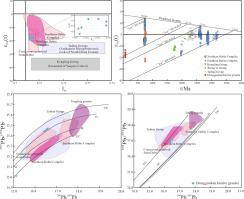Ore Geology Reviews ( IF 3.3 ) Pub Date : 2021-04-20 , DOI: 10.1016/j.oregeorev.2021.104163 Cheng Tang , Xiaoyong Yang , Insung Lee , Longhu Wang , Qianming Zhang

|
The newly discovered large-scale Donggushan tungsten polymetallic deposit with resources of 70,000 t WO3 and 38,000 t Mo, located at the Lujiang county, center of Anhui Province, East China. The deposit is characterized by skarn W-Mo mineralization, which is developed along the external contact zone between the biotite granites and carbonate rocks. Zircon U-Pb dating yields a Late Cretaceous age of 98.3 ± 1.6 Ma for the Donggushan biotite granite. The hidden biotite granites of Donggushan is characterized by high silica and alkali but low Mg, Fe. It is enriched in light rare earth elements (LREEs) and large ion lithophile elements (LILEs: Rb, K, Th and U), but strongly depleted in heavy REEs, and high field strength elements (HFSEs: Nb, Ta and Ti), and Sr. This high-K granite has medium initial 87Sr/86Sr ratios (0.706518–0.707116) and low initial Pb isotopic ratios [(206Pb/204Pb)i, 16.452–16.533; (207Pb/204Pb)i, 15.449–15.463; (208Pb/204Pb)i, 36.946.335–37.097], and is characterized by low εNd(t) and εHf(t) values (−22.1 to −16.1 and −21.3 to −15.1, respectively). All these data indicate that the Donggushan biotite granite is a high-K calc-alkaline fractionated I-type granitite. This granite may have derived from a crustal source, which is dominated by the Northern Dabie Complex (NDC) mixed with the basement materials of the Taihua Group. The magmatism in the Donggushan polymetallic deposit is quite different from those in the metallogenic belts of the Qinling-Dabie Mo belt (QDMB) and Middle-Lower Yangtze River Belt (MLYB). Based on the geochemical study of REEs of scheelite, it is proposed that the substitution mechanism of Ca2+ + W6+ = REE3+ +Nb5 + occurred during the formation of scheelite. Concentrations of Eu indicate that scheelite precipitated under the oxide conditions. The variations of the Mo concentrations might be caused by the changing of oxide reduction conditions. The Sr of the scheelite and S isotopes of pyrite in the Donggushan deposit reflect a complex magmatic-hydrothermal mineralization process within the intrusion and the country rocks.


























 京公网安备 11010802027423号
京公网安备 11010802027423号